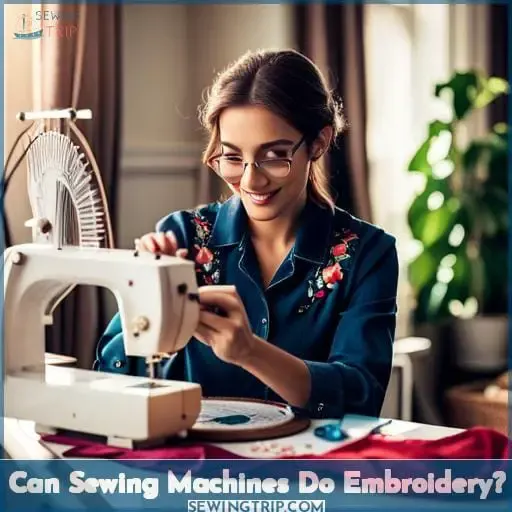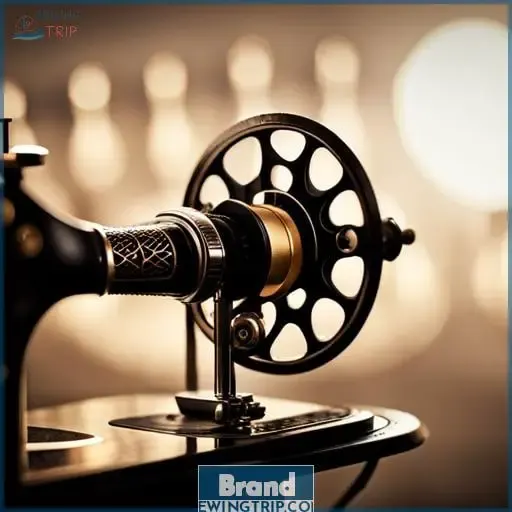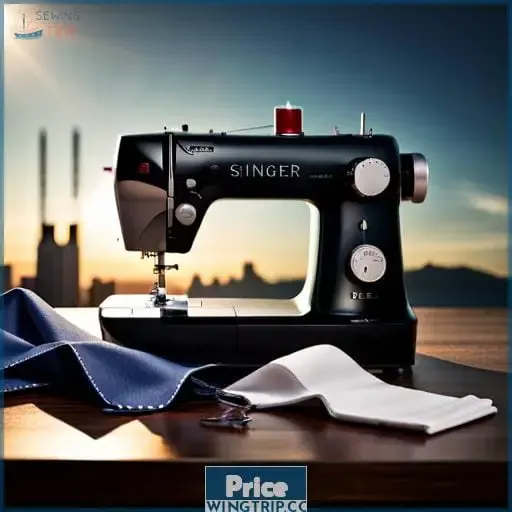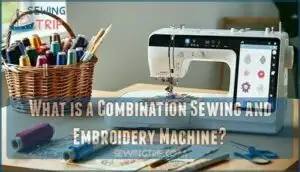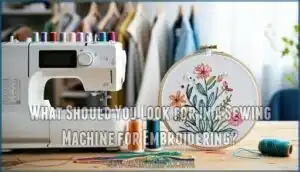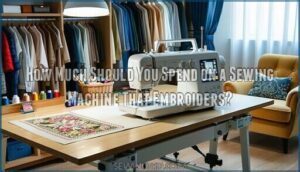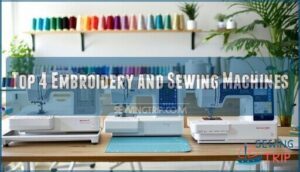This site is supported by our readers. We may earn a commission, at no cost to you, if you purchase through links.
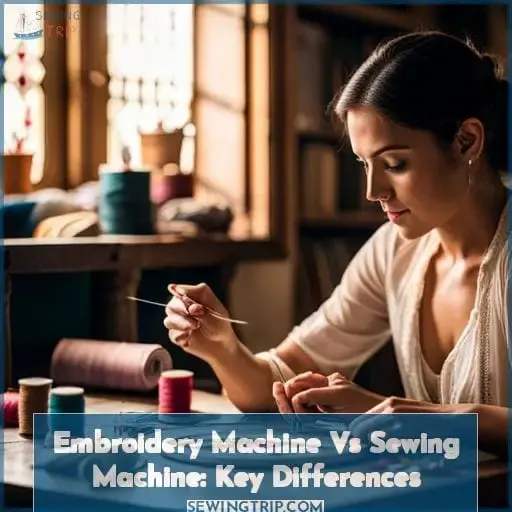
But before you can craft your vision, know the differences. Sewing machines and embroidery machines both loop threads together, yet have distinct functions. Sewing machines ply fabric edges, while embroidery machines embellish fabric surfaces.
Sure, you can free-motion embroider with a sewing machine, but true mastery comes from the right tools. As you shop, prioritize sewing features like stitch selection and adjustable presser foot pressure.
With expertise guiding your selection, your next creation awaits. Craft on.
Table Of Contents
- Key Takeaways
- Embroidery Vs Sewing Machines
- Can Sewing Machines Do Embroidery?
- Brand
- Price
- Care
- What is a Combination Sewing and Embroidery Machine?
- What Should You Look for in a Sewing Machine for Embroidering?
- How Much Should You Spend on a Sewing Machine That Embroiders?
- Top 4 Embroidery and Sewing Machines
- Frequently Asked Questions (FAQs)
- Conclusion
Key Takeaways
- Sewing machines join fabric edges.
- Embroidery machines decorate fabric surfaces.
- Combination machines allow both decorative and functional stitching.
- Beginners can start with a combination machine and upgrade for more embroidery capabilities.
Embroidery Vs Sewing Machines
Thanks for the thoughtful background on embroidery and sewing machines. Let’s delve into the differences between these two machine types. With firsthand experience using both, you’ll find that embroidery and sewing equipment serve unique creative needs.
While sewing constructs and embroidery embellishes, smart crafters know that today’s combo models open up boundless project possibilities.
Embroidery Versus Sewing
You’d be amazed at how far both arts have come since their early days of luxury and functionality. With thread color guides, stabilizer types, and proper hooping, embroidery unleashes your inner artisan.
Digitizing software features and pattern books offer unlimited creative potential. Yet a trusty sewing machine remains essential for functional crafts. Mastering the stitched line empowers your liberation.
With practice, these machines become paintbrushes for fabric canvas, awakening your inner power and mastery.
Embroidery Machines Versus Sewing Machines
You could compare an embroidery machine and a sewing machine to see which one best suits your creative needs. Embroidery machines excel at decorative stitching to embellish fabrics. Use them to add monogram patterns or custom designs.
Sewing machines handle functional stitching for constructing and mending clothes. Keep either machine clean and oiled for the best performance. Select a sewing or embroidery machine based on your project goals.
Can Sewing Machines Do Embroidery?
You bet, sewing machines can do embroidery with the right accessories and know-how. While dedicated embroidery machines offer more versatility, many standard sewing machines can produce beautiful embroidery by lowering the feed dogs, using proper stabilizers, and swapping out the foot.
With high-quality thread, tiny needles, the right settings, and bobbin tension adjustments, you’ll be surprised what sewing machines can embroider. The results may not rival commercial machines, but you can absolutely embellish projects with stitchwork using a normal household sewing machine.
Can You Use Embroidery Thread in a Sewing Machine?
Y’all can totally use embroidery thread in a regular sewing machine if you make some adjustments to the tension and use the right needle for the thread thickness. Back in my day, we’d swap out threads and make stuff sparkle, even on our rickety old Singers.
You’ll want a sharp needle to pierce the tightly twisted threads without fraying. Reduce your top thread tension so the bobbin doesn’t get pulled up on the bottom side. Try a straight stitch first to get your tension dialed in before attempting zig-zag or decorative stitches.
Going slow helps the machine handle thick embroidery threads when stitching curves and corners.
Use an embroidery stabilizer if stitching a filled shape to prevent tunneling on fabric.
Do Embroidery Machines Also Sew?
Some embroidery machines do double-duty as sewing machines, letting you tackle both decorative and functional stitching. With the right accessories and settings adjustments, your embroidery machine can handle basic sewing tasks.
- Get the right presser feet for sewing needs
- Adjust thread tension when switching tasks
- Take a combo machine class to master both
- Test with scraps to get stitch settings right
Embroidery machines won’t replace a dedicated sewing machine. But with practice, you can expand their abilities beyond just decorative stitching.
Are Embroidery Machines as Durable as Sewing Machines?
Straining against the confines of your craft, see wonders blossom beneath nimble fingertips.
Embroidery machines prove as hardy as their sewing counterparts when cared for properly. Their sturdy build protects from vibration, and regular oiling and tune-ups ensure longevity. However, sewing machines handle thick fabrics better. Additionally, the embroidery capacity remains limited by hoop size.
Brand
Your foolproof Bernette delivers steady stitching and color embroidery.
- Gadgets for downloadable designs open creative possibilities.
- Regular service keeps your machine running smoothly.
- Quality needles and threads prevent frustrating breaks.
Stitching and embroidery share basics like fabric and needles, yet excel at different creative needs. For versatile at-home use, a sewing machine handles garment construction and mending while adding simple designs.
An embroidery machine becomes your art studio for expressive accents, logos, and customization. With computerized models, subscriptions offer an ever-expanding design library to suit your style.
While limited stitches challenge a sewing device to embroider, a dedicated embroidery gadget gives you total creative control. Both crafts need practice, but with the right tools, you can master precise stitches, flowing designs, and durable construction infused with your personal touch.
Price
You’d think price determined quality, but some bargain brands outperform the pricey ones.
| Machine Type | Price Range | Considerations |
|---|---|---|
| Basic Sewing | $100-$300 | Limited built-in stitches and features, but fine for learning basics |
| Intermediate Sewing | $300-$600 | More stitches, automatic features like threaders |
| Advanced Sewing | $600-$1500 | Computerized, specialty stitches and feet |
| Basic Embroidery | $300-$800 | Small hoops, limited designs |
| Intermediate Embroidery | $800-$1500 | Larger hoops, more built-in designs |
| Advanced Embroidery | $1500+ | Multi-needle, huge hoops, design customization |
With experience, you’ll get a feel for what combination of price and features fits your needs. Focus more on convenience and capability than cost. Resist overspending, but don’t deprive yourself of creative potential.
Care
You’re advised to lubricate your combo machine regularly for longevity, whether embroidering or sewing.
- Use quality oil and lubricant designed for sewing machines. Avoid household oils, which can gum up mechanisms.
- Oil moving parts like the hook race and bobbin area every 3-5 bobbins used.
- Apply lubricant to points where metal touches metal to prevent friction and wear.
- Consult your manual for oiling recommendations specific to your make and model.
- Service your machine professionally at least once a year for a tune-up.
Regular cleaning and oiling will extend the life of your sewing and embroidery machine. Proper machine maintenance gives you smooth operation and quality results on all your projects.
What is a Combination Sewing and Embroidery Machine?
You’ll find liberation in a combo machine, unlocking decorative possibilities beyond just functional stitching. Embrace your creative power by selecting from hundreds of built-in designs and an array of thread colors, switched out automatically.
With consumer education, an expanded world of embroidery opens up – no need for multiple machines. A single needle stitches any design your heart desires, framed by an embroidery hoop. Touchscreen controls allow easy selection and customization of visual effects. Pricing varies, but combo machines provide great value, combining essential features for both sewing and embellishing.
Accessories further expand your options. Master this versatile machine to make your wildest creations come alive with texture and depth.
What Should You Look for in a Sewing Machine for Embroidering?
You’ll want to evaluate the sewing features such as stitch options, presser feet, and accessories to ensure that the machine can handle your typical sewing projects. Also, examine the embroidery capabilities, especially hoop sizes and built-in designs, to make sure that the machine has the embroidery features you need.
Selecting a machine that excels at both sewing and embroidering gives you the most versatility in your craft room.
Sewing Features
When finding the perfect combo machine, look at the quality and variety of stitches and presser feet. Opt for many built-in stitches to handle construction, decorative work, and stretch fabrics. Make sure presser feet suit your project plans, like a zipper foot or walking foot.
Consider convenience features like needle up/down, speed control, and knee lift. Test drive models to ensure intuitive screens, easy threading, and reliable tension. Fancy decorative stitches are less important than a strong straight stitch and precise buttonholes.
Prioritize a machine meeting your skill level and project needs over marketing claims.
Embroidery Features
As your embroidery aspirations expand, hoop size, built-in designs, and scan/download capabilities will satisfy your cravings for machine versatility. Look for a hoop size of at least 5×7 inches for most projects. Hundreds of built-in designs allow for immediate embroidery, while scanners and downloads offer unlimited future options.
Compatible software opens up more creative possibilities. Consider a machine with an open arm for tubular embroidery and enough space for bulky fabrics.
How Much Should You Spend on a Sewing Machine That Embroiders?
Setting a budget helps guide your combo machine search, but don’t sacrifice quality just to save a buck.
Consider how often you’ll use the machine. More frequent use calls for investing in a higher-end model built to withstand months of fabric and thread.
Factor in the fabric weight and stabilizer choices common for your projects. Sturdier machines can confidently handle heavy denim or piles of fleece.
Estimate your expertise level. Beginners often prefer budget models with basic functions.
Quality materials and workmanship directly relate to machine price and brand. Resist deals that seem too good to be true. Though tempting, flimsy machines frustrate more than they create. Prioritize long-term satisfaction over short-term savings when choosing your creative partner.
Top 4 Embroidery and Sewing Machines
Crafters looking to expand their crafting capabilities should consider the promising features of popular combo machines like the user-friendly Brother SE600, the versatile high-end Bernette 79, the app-connected EverSewn Sparrow X, or the starter Singer Legacy SE300.
With experience using all types of sewing machines, I can offer firsthand advice on deciding between these models and guide you to the best match for your budget and projects based on performance factors like built-in designs, stitch quality, and ease of use.
Brother SE600 Sewing and Embroidery Machine
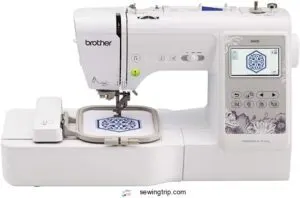 View On Amazon
View On Amazon
You’ll adore creating decorative masterpieces with the versatile Brother SE600. With 80 built-in embroidery designs and 103 sewing stitches, this machine empowers your creative expression. Simply select designs on the touchscreen and let the automated threading and bobbin features do the busywork.
The generous 4 x 4 embroidery field handles most projects. Adjustable speed settings help you achieve flawless results as you gain expertise.
Though not without limitations, the SE600 opens boundless potential.
- Large selection of built-in designs
- Made sewing and embroidery accessible for beginners
- Convenient automatic needle threading
- Touchscreen is not the most user-friendly
- Lacks capability for programming custom stitches
- Some intermittent jamming issues reported
Bernette 79
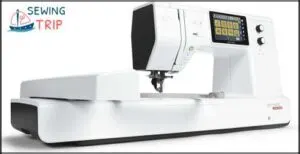 View On Amazon
View On Amazon
My oh my, that shiny Bernette 79 will have your creative juices flowin’ like a river with its gazillion stitch options and monster embroidery field! You’ll be pumpin’ out personalized tees, next-level quilts, and fairytale wall-hangings before you can say sew what!
This precision-crafted Swiss beauty glides through denim and velvet like butter thanks to its sturdy aluminum frame and dual-feed tech. Large or lumpy? No prob for the expansive work area. Lemme tell ya, them high-powered LED lights illuminate like a stadium so you won’t miss an intricate detail.
While your equipment hums a merry tune, that crystal clear touchscreen makes pattern pickin’ a breeze. And you’ll never struggle with tangled threads again thanks to the semi-automatic needle threader and auto cutter.
- Large embroidery field and throat space
- Dual feed for even fabric feeding
- Semi-automatic needle threader
- Programmable foot control
- High price point around $2000
- Learning curve for advanced features
- Troubleshooting issues can be time-consuming
- Many features may go unused by beginners
EverSewn Sparrow X Next-Generation Sewing and Embroidery Machine
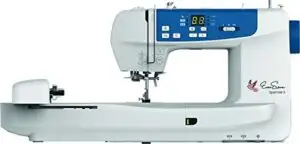 View On Amazon
View On Amazon
While lacking embroidery capabilities, the EverSewn Sparrow X offers advanced sewing features that make it a versatile option for intermediate sewers exploring machine embroidery. You’ll appreciate its quick 850 RPM stitching speed and compact footprint – perfect for tackling most projects in a tight craft room.
The backlit LCD screen and app integration smoothly guide you through stitches and settings.
Though the 4.75 x 7 inch hoop won’t impress experienced embroiderers, it lets you test small designs and personalize your makes. With practice, integrating simple embroidery into your sewing unlocks new creative potential.
Don’t expect perfection right away – mastering both crafts takes time. But leaning into the learning process awakens your inner artisan. Each iteration refines your vision, transforming raw materials into treasures imbued with care and meaning.
Embrace small beginnings on your embroidering journey – with persistence, your skills will blossom.
- Fast 850 RPM stitching speed
- Compact size
- Backlit LCD screen
- Smart device integration
- Small 4.75 x 7 embroidery area
- Embroidery often fails
- Not beginner friendly
Singer Legacy SE300 Embroidery Machine
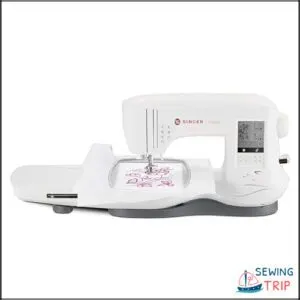 View On Amazon
View On Amazon
Despite its embroidery weaknesses, those sharp enough will cut through the tangled bobbin tension and reap the homemade harvest of this bargain workhorse. Though every machine must be measured on its own meter, arm yourself with patience to master this peculiar creature.
Some find the manual lacking, but with practice, its quirks become character. Your craft room may feel crowded at first by the extra 197 built-in patterns. But clever creators see white space – snap-on hoops frame blank fabric, eager for expression.
What the SE300 lacks in finesse, it compensates in versatility. With strategy and skill, its deficiencies become opportunities. Like any machine, consistent care extends its lifetime, so clean and oil it regularly.
Approach with realistic expectations, and it could be the cornerstone of your creative workbench.
- 250 built-in stitches offer creativity
- Large embroidery area
- Bobbin winding while embroidering
- 10 snap-on presser feet add versatility
- Must purchase software separately
- Complicated instructions
- Automatic threading inconsistencies
- Not an authorized SINGER dealer, no warranty
- Embroidery not as easy to use as expected
Frequently Asked Questions (FAQs)
What fabrics can I embroider on my sewing and embroidery machine?
You’ll have success embroidering most woven fabrics like cotton, linen, and polyester. Tightly woven fabrics hold embroidery stitches best. Avoid super stretchy knits until you’re experienced – the stitches may pucker.
Always use stabilizer underneath to support the fabric and keep it taut as you embroider. An all-purpose cutaway stabilizer works for most projects. Don’t fret over fabric type – just start practicing on scraps to get comfortable.
How do I know which hoop size to use for my embroidery projects?
When choosing an embroidery hoop, go with the smallest size that fits your design. Using too large a hoop can distort the fabric and cause registration issues. Make sure the hoop provides about 2-3 inches of space around the design.
What threads and bobbins work best for embroidery?
You’ll want embroidery thread and bobbins designed for machine embroidery. Polyester embroidery thread provides strength and elasticity to handle the constant needle piercing. Pre-wound polyester bobbins ensure smooth unwinding without tangles or jams. Match the weight of the thread and bobbin so the tensions balance during stitching.
Heavy threads like rayon require a heavier bobbin thread. For most machine embroidery, stick with quality poly threads and bobbins made for your machine.
How do I transfer or upload embroidery designs to my machine?
First, download the design files to your computer. Then, use a USB cable or memory card to transfer them into your machine’s internal memory or directly onto the screen. Make sure that your machine’s firmware supports the file format – .pes works universally.
What maintenance does an embroidery machine need that a regular sewing machine doesn’t?
You’ll need to clean under the needle plate regularly because the built-up lint can cause poor thread tension. Oil the machine every month to lubricate the moving parts. Frequently remove the hoop to eliminate hoop burn residue.
Embroidery heads need professional servicing every 1-2 years. Finally, use high-quality thread to avoid thread breaks that damage the machine over time.
With proper care, your embroidery machine will deliver years of beautiful stitched artwork! Let me know if you need advice on maintenance or have any other questions.
Conclusion
Let’s say you’re a beginner sewist looking to try machine embroidery. I’d suggest starting with a versatile combo unit like the SE600. It won’t break the bank, and you’ll be able to dip your toes into decorative stitching.
As you gain experience, you may want advanced embroidery capabilities – that’s when a heavy-duty model like the Bernette 79 is worth investing in. The differences between embroidery and sewing machines come down to versatility, features, and specialization.

